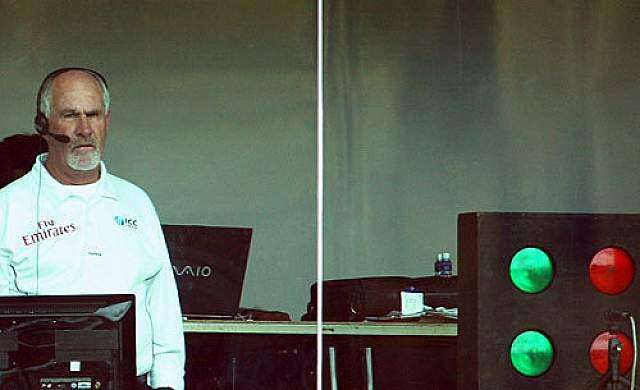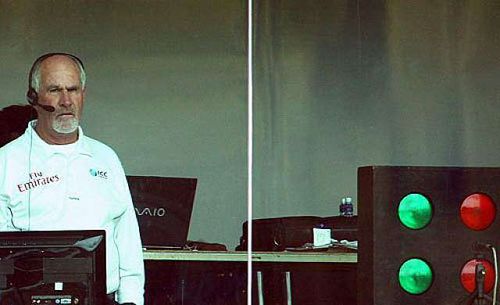
What goes through the Third Umpire’s mind during a DRS referral?

In a recent Test between India and England, on-field umpire Paul Reiffel was hit by a throw from the outfield after which he had to leave for treatment. Subsequently, the Third Umpire, Marais Erasmus stepped in taking his place as the on-field umpire and Fourth Umpire Shamshuddin became the Third Umpire. To make matters worse, Shamshuddin had to take couple of really tough calls and although, sanity prevailed, it was obvious that he was a little underprepared for that job.
No one knows if he actually felt underpaid, and went to the ICC saying, “I did more than what I signed up for!” After all, not everyone can transform himself into the Dark Knight when the situation demands. The Third Umpire is the gadget-guru of a cricket match, with all funky tools at his disposal. While they don’t match up to what Batman has, he is still one of the most powerful people in the game. He gets to tell the on-field umpires – “You are wrong, brother!” How the playing captains wish, they could say that.
So, what exactly goes through the Third Umpire’s mind every time there is a DRS appeal when the batting team or the bowling team is clearly unhappy with the on-field decision? DRS appeals are generally made for caught-behind (or caught in slips) and LBW decisions. DRS appeals make one feel like a stubborn child who wants to complain to daddy about mommy not giving him the cookie. The Third Umpire, therefore, gets to show, Who is the Daddy! Here are a few things that probably go through his head!
Can you please over-step and we can call it a day?
I am sure, every time, there is a DRS referral, the Third Umpire probably thinks, God please ensure the bowler has overstepped. Because that is the first thing he has to check. If the bowler oversteps, we don’t need to worry about Ball Tracking or Ultra-Edge/Hot Spot anymore. It is simply a no-ball. Call it a no-ball and we can get back to chilling in the AC cabin. Same pay, less work. Who wouldn’t want that?
God, I need my space
We all need our space, in relationships; at work; in life. Even the Third Umpire does. That is why, when there is a DRS referral, every Third Umpire secretly hopes for space. A centimetre is a big measurement in cricket. Al Pacino’s famous Inch by Inch speech was apt for football but in cricket, an inch is a big deal.
Edges are close, very close and the Third Umpire probably very obviously wants or rather hopes for decisions where he has the space. So, the first thing he probably looks for is the gap between bat and the ball, especially on tight calls. If there is daylight between bat and ball, the Third Umpire probably sees light at the end of the tunnel!
Hope the Ultra-Edge doesn’t get my blood pressure up
The Ultra-Edge spikes whenever there is a sound. It picks up the sound, which begs the question, why it is called Ultra-Edge? Talk of marketing gimmicks, because it is not there to pick the edge. It could pick the sound of the bat hitting the ground too and god save the Third Umpire when the bat hits the ground exactly at the same time as the ball passing the edge of the bat.
“Where did the sound come from?” then is what the Third Umpire will die wondering – a little like trying to figure out who is the source of the bad smell in a cab with five people. The spikes are funny too. Smaller spikes for soft sounds and longer spikes for hard sounds.
And just when the Third Umpire gets his head around what is small and what is hard, no puns intended, someone comes about with a new term – ‘a feather’. Even the batsman doesn’t feel that edge they say. When given out, the batsman protests, refers to the DRS, chewing away at his gum, like Ben Stokes did, and walks away furiously when eventually given out. If the ball kissed the edge, God save me from the edge, the Third Umpire probably thinks. These bats have massive edges these days too!
What’s a god damn hot spot?
The Hot Spot for the layman looks like an X-Ray. Some things light up including the batsman’s inner-wear sometimes and some things don’t. And there have been cases in the past where there was a noise but no hot spot. Guess, technology likes batsmen like VVS Laxman a little too much, Vaseline or no Vaseline on the edge. The Third Umpire has the unenviable job of trying to find out which spot on the bat came from the ball and which one doesn’t.
Generally, it is easy, but then sometimes, the bat and ball do a little bit of kiss-and-don’t-tell and the sound tells you what the Hot Spot doesn’t. Then you are caught in the Prisoner’s Dilemma. Do I have enough to reverse the on-field umpire’s call and that question probably changes something inside. Third Umpire’s probably become nicer people in real life too, rarely arguing when they don’t have enough evidence to prove the other person wrong, logic be damned!
Umpire’s call or more aptly put, split personality disorder
Third Umpires generally hope they don’t get DRS appeals that end up being umpire’s call. It is like having all the cool gadgets to make the right decision and be Batman and still end up losing to Joker. Because the umpire’s call is one of cricket’s paradoxes, designed more to protect the on-field umpire than the sanity and integrity of the game.
The same ball, after pitching on the same spot and hitting the pad at the same place and hitting the stumps, in the same way could lead to an Out or a Not-Out depending on what the on-field umpire thought about it. If the on-field umpire thought it was out and as a batsman you challenged it, you lose. If he thought it was not-out and as the on-field captain, you challenged the decision, you lose.
Remember, the ‘House always wins’ rule in Las Vegas? The Third Umpire would probably want to say to the on-field umpire, ‘Bro, you’ve got that wrong but then I have your back!’